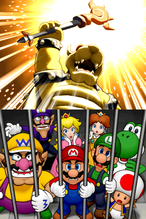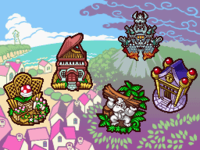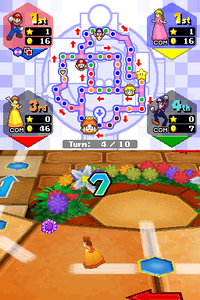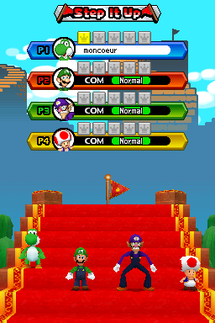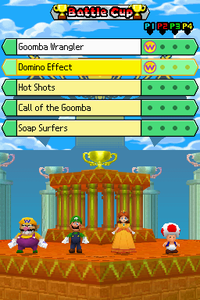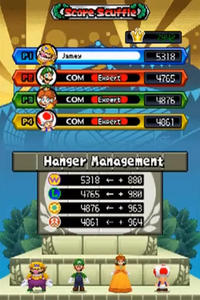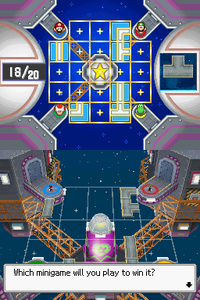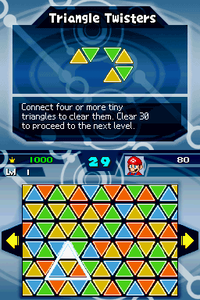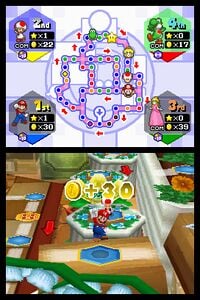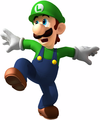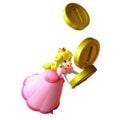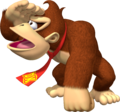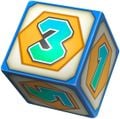Mario Party DS
| Mario Party DS | |||||||||||||||
|---|---|---|---|---|---|---|---|---|---|---|---|---|---|---|---|
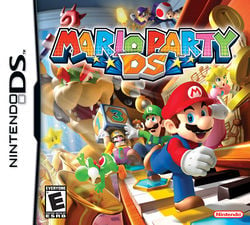 North American game cover. For alternate box art, see the related gallery. | |||||||||||||||
| Developers | Hudson Soft CAProduction Nintendo SPD Group No.4 | ||||||||||||||
| Publisher | Nintendo | ||||||||||||||
| Platforms | Nintendo DS, Virtual Console (Wii U) | ||||||||||||||
| Release dates | Nintendo DS: Virtual Console (Wii U): | ||||||||||||||
| Languages | English Japanese French (France) German Italian Korean Spanish (Spain) | ||||||||||||||
| Genre | Party | ||||||||||||||
| Ratings |
| ||||||||||||||
| Modes | Single-player, Multiplayer (single card) | ||||||||||||||
| Format | Wii U: Nintendo DS:
| ||||||||||||||
| Input | Wii U: Nintendo DS:
| ||||||||||||||
| Serial codes | |||||||||||||||
Mario Party DS is the fourteenth installment in the Mario Party series. It was released for the Nintendo DS in late 2007, as the last Mario Party game by Hudson Soft before Nintendo Cube took over starting from Mario Party 9, as well as the last Super Mario game developed by Hudson Soft before their dissolution in 2012. The game was later released for the Wii U Virtual Console in April 2016.
Story[edit]
From the instruction booklet:[10]
The Mario crew's adventure begins late one night when five Sky Crystals fall to earth. Mario finds one, then shows it to all of his friends!
Just then there's another surprise. Bowser sends party invitations to the whole crew: "Hey, chumps! I'm throwing a Big Bowser Bash to apologize for being such a big jerk!"
Of course, they're all suspicious! But free eats can't be beat, so everyone goes to Bowser's Castle to get first crack at the snacks. And, of course, it's a trap! Bowser steals the Sky Crystal, then shrinks everyone with his new Minimizer. So tiny in such a big world!
Bowser doesn't want Mario and company in the way, since he has four more Sky Crystals to find. So he flings them to the far side of the kingdom!
And there our party begins, with our wee heroes lost in a world full of gigantic challenges...
One night, five Sky Crystals fall down to the Mushroom Kingdom. When a Sky Crystal lands near Mario, he proceeds to tell his friends the next day. Suddenly, Kamek flies overhead, dropping invitations to a feast in Bowser's Castle to apologize for his wrongdoings, which Donkey Kong and Diddy Kong also receive unintentionally. The apology was insincere, as Bowser and Bowser Jr. drop a cage on Mario and his friends, trapping them, and steals Mario's Sky Crystal to power the Minimizer and shrink the characters to a very small size. Mario and the others are thrown far away as Bowser goes searching for the remaining Sky Crystals. Mario and his friends all went to get back at Bowser and return to normal size, but they compete for the Superstar at various boards along the way.
Wiggler is the first to ask for help, as Wiggler's Garden has been overrun by a Piranha Plant.[11] When the Superstar defeats the Piranha Plant, Wiggler gives the characters the first Sky Crystal. At the next destination, Toadette's Music Room, the characters are asked by Toadette to get rid of a destructive Hammer Bro.[12] When the Superstar defeats Hammer Bro, Toadette gives the characters the second Sky Crystal. At the third destination, DK's Stone Statue, Diddy Kong informs the characters that Dry Bones had turned Donkey Kong into a statue.[13] When Dry Bones is defeated, Donkey Kong returns to normal and Diddy gives the characters the third Sky Crystal. The fourth destination, Kamek's Library, has a Koopa Troopa who informs the heroes that his grandfather, Koopa Krag, has been imprisoned into a book.[14] The Superstar defeats Kamek at the end of a long hallway, freeing Koopa Krag, and the heroes receive the fourth Sky Crystal. Lastly, the characters arrive at Bowser's Castle, but as they attempt to ambush him, they forget that they are still shrunken. They are then put into a pinball machine by Bowser and Bowser Jr. By the time the prevailing character becomes the Superstar, Bowser attempts to shrink them again, but Donkey Kong and Diddy Kong arrive, expecting a banquet. Donkey Kong accidentally knocks the Minimizer outside of Bowser's hands and breaks it, reverting the characters to normal size.
For the final battle, Bowser takes out the Megamorph Belt to become Blockhead Bowser, battling the Superstar of Bowser's Pinball Machine. Upon defeating Bowser, the Superstar reclaims the last Sky Crystal, and all five of them combine to form the crystal DS, allowing play of Triangle Twisters. Bowser apparently wanted to have the Sky Crystals to try the challenge for himself, but the characters allow him and Bowser Jr. to play as well. Meanwhile, Donkey Kong and Diddy Kong feel satisfied, having finished the feast all by themselves.
Gameplay[edit]
Mario Party DS plays like the home console entries of the Mario Party series. Up to four players take turns to roll a Dice Block from 1 to 10, deciding how many spaces they can move. Each player tries to get the most Stars by the end, depending on the condition set by the board. After all players have had their turn, the type of minigame determines the type of minigame that will be played, such as one player landing on a Red Space (including a Bowser Space) and others on a Blue Space initiating a 1 vs. 3 minigame. Whoever wins the minigame is rewarded ten coins, and the next turn starts. In the Final 5 Frenzy event, when the last five turns have begun, Bowser allows the player in last to spin a roulette for a prize, as well as changing all Friend Spaces to Duel Spaces.
A Battle Minigame may occur, in which case a set number of players' coins are taken from them, with no penalty for players with an insufficient number of coins. When the minigame concludes, players 65, 30, 5, or 0 percent of the coins, depending on their ranking. The number of coins that each player has to pay is determined by the current turn number multiplied by two.
Once the set number of turns are over, the game ends, and the total number of Stars and coins collected by players are tallied, the winner is announced, especially over how many Stars they have collected. In Party Mode, three Bonus Stars can be rewarded to any players for excelling at certain criteria the most: Mini-Game Stars for anyone who has won the most minigames; Green Stars for whoever has landed on the most ? Spaces; Running Stars for whoever has moved the most spaces; Item Stars for whoever has used the most items; Hex Stars for whoever used most Hexes; and Friendship Stars for anyone who has landed on the most Friend Spaces.
Spaces[edit]
| Image | Space | Description | Rarity |
|---|---|---|---|
| Blue Space | The most common space, Blue Space gives three coins when landed on. A Hidden Block can appear here. | Common | |
| Red Space | The opposite of a Blue Space, where the player loses three coins. | Semi-rare | |
| Green Space | An event occurs, depending on the board and its position. The top screen interface gives that player a green background, flashing randomly to red or blue before a minigame begins. | Semi-common | |
| Friend Space | The player receives five coins, as well as an opponent of choice. The top screen gives that player a green background, like Green Spaces. | Uncommon | |
| Duel Space | Replacing Friend Spaces in the Final 5 Frenzy, Duel Spaces allow the player to choose an opponent for a Duel minigame then spin a roulette to determine the prize for winning. The top screen gives that player a green background, like Green Spaces. | Uncommon | |
| Bowser Space | Bowser arrives to cause an event at the player or players' disadvantage: Gimme Coins! has Bowser takes away 20 of the player's coins (10 if they have fewer or all if they have even fewer); Gimme Stars!, has him take away one Star; Gimme Charity! has Bowser forcing the player to give 10 coins to all opponents (or just the opposing team in Team Battle); and Gimme Equality! has Bowser give all players the same number of coins. | Rare | |
| Star Space | When a player makes it here, they can pay 20 coins for a Star. It is the only space that is not counted by the dice roll. | One per board |
Items[edit]
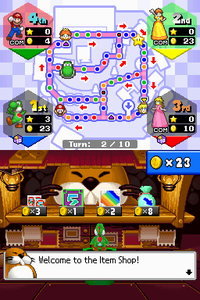
Items can help players. The normal type is usually bought from Item Shops, while the introduced Hexes are found at Hex Areas. Either way, only up to three of either type can be carried at once.
Normal items[edit]
Regular items can be bought at Item Shops run by a Monty Mole. Players can decide to purchase more than one item, unlike previous Mario Party games, provided that they have enough coins.
| Image | Name | Description | Price |
|---|---|---|---|

|
Double Dice Set | The player rolls two Dice Blocks. | 3 coins |

|
Triple Dice Set | The player rolls three Dice Blocks. | 7 coins |

|
Halfway Dice Block | The player can roll only between 1 through 5. | 1 coin |

|
Warp Dice Block | The player warps some place random before starting their turn. | 2 coins |

|
Snag Bag | The player steals a random item from an opponent of choice. | 8 coins |

|
Star Pipe | The player starts their turn from the Star Space. | 15 coins |

|
Block Sensor | The next space that is landed on contains a Hidden Block. | 20 coins |

|
Grab Bag | Rewards a Star Pipe, Block Sensor, and Triple Dice Set, getting rid of any previous items in their inventory. | 25 coins |
Hexes[edit]
- Main article: Hex
Hexes can be placed as traps on certain spaces by other players, similarly to Character Spaces from earlier Mario Party titles. A majority of Hexes negatively affect the opponent when landed on (except the Coin Block and Star Block). They can be replaced by a different Hex and dissipate after being used.
| Image | Name | Description |
|---|---|---|
| 10-Coin Hex | The opponent gives 10 coins to whoever placed the Hex. | |
| 20-Coin Hex | The opponent gives 20 coins to whoever placed the Hex. | |
| Coin Swap Hex | Swaps the opponent's number of coins with whoever placed the Hex. | |
| 1-Star Hex | The opponent gives 1 Star to whoever placed the Hex. | |
| 2-Star Hex | The opponent gives 2 Stars to whoever placed the Hex. | |
| Space Swap Hex | The opponent switches positions with whoever placed the Hex. | |
| Star Block | Whoever lands on the Hex can receive one to three Stars, depending on which number they hit on the block. | |
| Coin Block | Whoever lands on the Hex has to hit the block as much as possible to gain the most possible coins within 10 seconds. |
Characters[edit]
Playable characters[edit]
There are eight playable characters.
Board hosts/bosses[edit]
Each board has a host and a boss.
| Wiggler's Garden | Toadette's Music Room | DK's Stone Statue | Kamek's Library | Bowser's Pinball Machine | |
|---|---|---|---|---|---|
| Board hosts | Wiggler | Toadette | Diddy Kong | Kamek | Bowser |

|

|

|

|

| |
| Bosses | Piranha Plant | Hammer Bro | Dry Bones | ||

|

|

|
Supporting cast[edit]
These characters have only a minor role.
- Donkey Kong (appears in DK's Stone Statue)
- Koopa (appears in Kamek's Library)
- Koopa Krag (appears in Kamek's Library)
- Bowser Jr. (appears in Bowser's Pinball Machine)
Minigame enemies[edit]
Boards[edit]
| Picture | Name | Star acquisition | Boss | Boss Mini-Game |
|---|---|---|---|---|

|
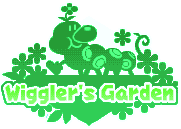
|
The Star moves elsewhere on the board after being bought for 20 coins. | Piranha Plant
|
Feed and Seed |
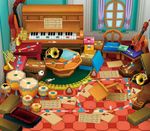
|

|
Players have to purchase Stars from Music Notes for 5-30 coins. | Hammer Bro
|
Hammer Chime |
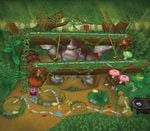
|
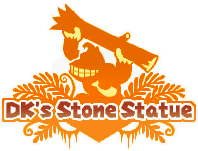
|
The Star is always just before the space at the top left. Players with a sufficient number of coins can purchase as many as desired at 20 coins each. | Dry Bones
|
Hexoskeleton |
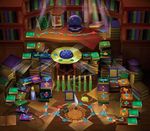
|
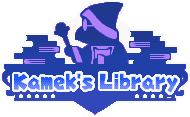
|
There are three magic jars with random contents: one with a Star; one 5 coins; and the other returning the player to the start. The jars change positions once the Star is obtained. | Kamek
|
Book Bash |
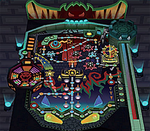
|
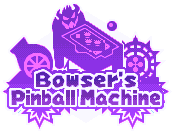
|
Same as Wiggler's Garden. | Bowser
|
Bowser's Block Party |
Team names[edit]
Every combination of playable characters in Tag Battle has their own team names:
Modes[edit]
Story Mode (1 Player)[edit]
A single-player mode where the player character has to go through the five boards, each requiring them to become the Superstar of a Battle Royal match, and then defeat its boss in a minigame before continuing. The opponents cannot be chosen, and the boards always have only ten turns and no Bonus Star awards. If a CPU player wins, they lose the boss minigame, forcing the player to restart the board all over. If there is a tie with a CPU character, the player always wins. The player can unlock expert difficulty for CPU players by clearing the board.
Party Mode (1-4 Players)[edit]
The player competes against either several players, whether humans or CPUs, on a board in either a Battle Royale, Tag Battle or Duel Battle.
Minigame Mode (1-4 Players)[edit]
The player plays can play unlocked minigames in a variety of challenges, again either human or CPU players.
Step It Up[edit]
- “Be first to reach the top of the steps! Minigame victories get you there!”
- —In-game description, Mario Party DS
Step It Up involves four players competing to win a number of randomly selected minigames, going up one step of a staircase upon winning. The player can decide upon 4-player, 1-vs-3 and 2-vs-2 minigames, or a mix of all three. For 1-vs-3 and 2-vs-2 minigames, teams are determined from the start but randomized if all three types of minigames are used. Whoever wins 3, 5, or 7 minigames first (as decided by the player) is the winner.
- Names in other languages
| Language | Name | Meaning | Notes |
|---|---|---|---|
| Japanese | かちぬきバトル[?] Kachinuki Batoru |
Tournament Battle | |
| French | Montée des marches[?] | Staircase run | |
| Italian | Scala del Successo[?] | Ladder of Success | |
| Korean | 승자진출전[?] Seungjajinchuljeon |
Winner Entry Game | |
| Spanish (NOA) | Escalera hacia el éxito[?] | Stair to success | |
| Spanish (NOE) | Poco a poco[15] | Little by little |
Battle Cup[edit]
- “Welcome to Battle Cup! In Battle Cup, you'll play five preselected minigames in order... And whoever wins the most of them is the victor!”
- —Narrator, Mario Party DS
Battle Cup involves four players competing to win the Cup Course, featuring a collage of five consecutive minigames chosen by either the player or the game. Only 4-player and Battle minigames are available. If multiple players win the most minigames by the end, the final winner is determined by each victor rolling a Dice Block.
- In-game description:
- English:
Choose a specific minigame course, then battle to come out ahead!
- English:
- Names in other languages
| Language | Name | Meaning | Notes |
|---|---|---|---|
| Japanese | バトルカップ[?] Batoru Kappu |
Battle Cup | |
| Italian | Punta alla Coppa[?] | Go for the Cup | |
| Korean | 배틀컵[?] Baeteulkeop |
Battle Cup | |
| Spanish | Torneo por victorias[?] | Tournament by victories |
Score Scuffle[edit]
- “Welcome to Score Scuffle! In Score Scuffle, you'll blast through 10 minigames. Results will be converted to points. The player with the highest final score wins!”
- —Narrator, Mario Party DS
Score Scuffle involves players playing through ten minigames, in the order of Rail Riders, Domino Effect, Cherry-Go-Round, Study Fall, Get the Lead Out, Whomp-a-thon, Hedge Honcho, Pedal Pushers, Hanger Management, and Raft Riot. Each time a player wins, they earn points (up to 1,000 points, except Get the Lead Out, where the maximum is 999 points), and whoever has the most points by the end is the winner. Score Scuffle has a default high score of 0 points.
- In-game description:
- English:
Compete in a series of minigames to earn as many points as possible!
- English:
- Names in other languages
| Language | Name | Meaning | Notes |
|---|---|---|---|
| Japanese | スコアアタック[?] Sukoa Atakku |
Score Attack | |
| Italian | Arraffapunti[?] | Grab Points | |
| Korean | 스코어어택[?] Seukoeo Eotaek |
Score Attack | |
| Spanish | Torneo por puntos[?] | Tournament by points |
Boss Bash[edit]
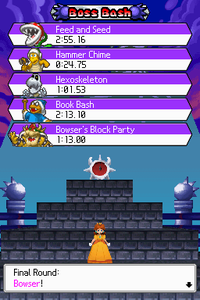
- “Welcome to Boss Bash! You're going to battle five bosses! How quickly can you defeat them? Bash them fast to win!”
- —Narrator, Mario Party DS
Boss Bash is a single-player minigame where the player faces bosses in their minigames, always in the order of Piranha Plant (Feed and Seed), Hammer Bro (Hammer Chime), Dry Bones (Hexoskeleton), Kamek (Book Bash), and Bowser (Bowser's Block Party). The player is given the objective the minigames as fast as possible because each one is timed. If the player is defeated at any point, the mode ends, and their scores are not recorded. Each minigame has a default high score of 5:00:00, making 25:00:00 the best time overall.
- In-game description:
- English:
Take on the boss minigames to get the best time you can!
- English:
- Names in other languages
| Language | Name | Meaning | Notes |
|---|---|---|---|
| Japanese | ボスタイムアタック[?] Bosu Taimu Atakku |
Boss Time Attack | |
| Italian | Sfida ai Boss[?] | Challenge at the Bosses | |
| Korean | 보스타임어택[?] Boseu Taim Eotack |
Boss Time Attack | |
| Spanish | Enemigos finales[?] | Final enemies |
Rocket Rascals[edit]
- “Welcome to Rocket Rascals! Reach the rocket first! Build a bridge to the center before your rivals do!”
- —Narrator, Mario Party DS
Rocket Rascals has four players compete to win minigames to acquire and place bridge pieces on the square 5x5 grid to make their way to the rocket at the end. Each turn starts with a roulette deciding which bridge piece the winner of a minigame will receive. The bridge piece can be placed on any unoccupied space of the grid, ending the turn. Rarely, the roulette will select a crosspiece, which can be placed on top of another piece. If either multiple or no players win the minigame, nobody gets the bridge piece. If it is not possible to make a route to the rocket, the obstructing pieces are removed. If multiple players reach the rocket at the same time, the winner is determined by whoever rolls the highest number on a Dice Block. If no one makes it to the rocket within 20 turns, no one wins.
Bowser Jr. sometimes appears after placing a bridge part and does one of five actions, decided by roulette: Crosspiece Crisis, where players play for a crosspiece every turn; Turnaround Madness, where Bowser Jr. scatters the bridge parts randomly; Tiebreaker Trouble, where Bowser Jr. places the piece if a tie occurs; Bridge Breaker, where Bowser Jr. steals all of the pieces, effectively restarting the mode; and Final Five Frenzy, which skips to the last five turns.
- In-game description:
- English:
Build a bridge to a rocket! Win your pieces by playing minigames!
- English:
- Names in other languages
| Language | Name | Meaning | Notes |
|---|---|---|---|
| Japanese | ミニゲームブリッジ[?] Minigēmu Burijji |
Minigame Bridge | |
| German | Raum-Randale[?] | Space riot | |
| Italian | Tutti al Razzo[?] | Everyone to the Rocket | |
| Korean | 미니게임브릿지[?] Minigeim Beuritji |
Minigame Bridge | |
| Spanish | Carrera espacial[?] | Space Race |
Puzzle Mode (1-2 Players)[edit]
One or two human players can play six puzzle-action games. The first five return from earlier Mario Party games, in the order of Mario's Puzzle Party, Bob-omb Breakers, Piece Out, Block Star, and Stick & Spin. There is also the touch-controlled puzzle game, Triangle Twisters, which has two play modes: Frenzy Mode and Focus Mode.
Multiplayer (2-4 Players)[edit]
From one Game Card, players use DS Download Play to play together in Party Mode, Minigame Mode (2-4 Players), Puzzle Mode and Extra Mode (2 Player).
Extras Mode (2 Player)[edit]
A multiplayer exclusive mode featuring Pen Pals and Desert Duel for cooperative and competitive play, respectively.
Minigames[edit]
- Main article: List of Mario Party DS minigames
Mario Party DS features 73 minigames from seven different categories: 32 are 4-player minigames (29 are also Duel minigames); 12 are 1-vs-3 minigames; 13 are 2-vs-2 minigames (three are also Duel minigames), 32 Duel minigames; five Battle minigames; five Boss minigames; and six Puzzle minigames. Mario Party DS is the last game with a specific Battle minigame category, with Free-For-All (4-Player) being used for later installments instead.
Gallery[edit]
- Main article: List of Mario Party DS collectibles
The player can view over 120 unlockable collectibles, as well as the game's music and any cutscenes of Story Mode that have been seen at least once.
Collection[edit]
- Main article: List of Mario Party DS collectibles
Mario Party DS features a variety of unlockable collectible items, including 71 board features, 30 character figurines, 25 trophies of defeated bosses, and 30 badges.
Regional differences[edit]
The Korean version omits the minigames Shuffleboard Showdown and Chips and Dips, and the roulette event of Bowser's Pinball Machine is replaced by a Whack-a-Mole game.
Quotes[edit]
- Main article: List of Mario Party DS quotes
- "The Mario crew's adventure begins late one night." - In-game text
- "I need help! That grouchy Piranha Plant is making a mess of my garden!" - Wiggler
- "That dumb Hammer Bro is beating up my music instruments! Get rid of him!" - Toadette
- "Get a load of this spell. I call it Kamek Spell No. 8!" - Kamek
- "Here's my Hammer Bro drum solo! HA! My music's so MOVING!" - Hammer Bro
- "Watch ME play, Dad! I'm the big pinball pro in these parts!" - Bowser Jr.
- "OK, I got this great gadget for our final fight! Cower before the power of my new Megamorph Belt!" - Bowser
Reception[edit]
Critical reception of the game was generally mixed to positive, garnering a 72 on Metacritic and 72.17% on GameRankings. Many critics praised the game as a major improvement over Mario Party Advance and Mario Party 8, the latter which was released the same year, and was praised for returning to the traditional gameplay from the console games and its multiplayer, graphics, minigames, and board designs. Criticism tended to focus on its perceived similarity to the previous games and its absence of online multiplayer.
| Reviews | |||
|---|---|---|---|
| Release | Reviewer, Publication | Score | Verdict |
| Nintendo DS | Frank Provo, GameSpot | 8/10 | "Mario Party DS is an outright blast when played with other people, and since you need only one cartridge to enjoy everything, the odds are good that you'll be able to entice your DS-owning friends to play with you. As a solo endeavor, challenging the computer opponents does get old eventually. However, between all of the different minigames, play modes, and puzzle games, it'll be a while before you condemn the cartridge to your storage shelf." |
| Nintendo DS | Ellie Gibson, Eurogamer | 4/10 | "Decent visuals and bonus puzzle games aren't enough to make Mario Party DS worth a purchase. It suffers from the same problems as the other games in the series. The mini-games, on the whole, are badly designed and boring. Watching other players take turns round the board is tedious. Even if you win every single mini-game, the stupid star system means you could still lose overall. It would seem there are plenty of gamers who are happy to put up with all this, however - after all, Nintendo wouldn't keep churning out Mario Parties if people didn't keep buying them. If you're one of those who has enjoyed the series on console, you'll enjoy it on DS. Otherwise, steer clear." |
| Nintendo DS | Craig Harris, IGN | 7/10 | "After ten years of playing board games with mini-games, it's honestly very difficult to get excited for yet another Mario Party; even though it's the first time it's been made for the Nintendo DS system. What's here is a solid multiplayer mini-game experience with a lot of the flaws of the previous versions. It doesn't do anything truly special than create a bunch of touch screen and microphone-centric minigames (and even then we've seen variations of them in other DS titles), but it at least comes together as a better title than the last console Mario Party design." |
| Aggregators | |||
| Compiler | Platform / Score | ||
| Metacritic | 72 | ||
| GameRankings | 72.17% | ||
Staff[edit]
- Main article: List of Mario Party DS staff
Mario Party DS was worked on by both Hudson Soft and Group No. 4 of the Nintendo SPD. Its game, planning, program, visual, sound and senior directors were Kouji Matsuura, Yuka Sasaki, Hideki Nishmoto, Akhiro Shibata, Ichiro Shimakura and Kenji Kikuchi respectively. Satoru Iwata and Hidetoshi Endo were the game's executive producers.
During the credits the eight playable characters run into view periodically. The player can tap on the characters once they've run into full view on the Touch Screen with the stylus to make the tapped character jump, and can continue to do so for the remainder of the credits.
Pre-release and unused content[edit]
Players used to have their own boxes at the top screen that have the "X" in the Coins storage and the Stars storage. In the final version, it was removed, because Coins can reach over 100. Also, the color used for the numbers that appear after earning or losing coins/Stars were gold instead of blue or red.
A debug menu can be accessed through Action Replay codes. The debug menu is displayed in the touch screen.[16]
Gallery[edit]
- For this subject's image gallery, see Gallery:Mario Party DS.
Multimedia[edit]
- For the complete list of media files for this subject, see Multimedia:Mario Party DS. For this subject's sound test, see Mario Party DS sound test.
| File info 0:30 |
| File info 0:30 |
| File info 0:30 |
| File info 0:30 |
References to other games[edit]
- In the Call of the Goomba minigame, the grinder plays the Ground BGM. The music for the Boogie Beam minigame is an arrangement of the Underground BGM.
- Mario's Puzzle Party returns as a Puzzle minigame, and the character icons for Mario, Luigi, Peach, Yoshi, Wario, Daisy, and Waluigi are reused in it as well.
- The sheet music visible in Toadette's Music Room contains the melody of the minigame theme "Let's Get a Move On".
- Bob-omb Breakers returns as a Puzzle minigame, and all the characters' victory and losing animations are recycled.
- The place markers are reused from this game.
- Piece Out returns as a Puzzle minigame. The winning and losing mugshots are also reused.
- Block Star returns as a Puzzle minigame.
- Peach and Daisy's artwork are recycled from this game.
- Yoshi's artwork is a modified version of his artwork from this game, which depicts him holding Mario's Cap over his head.
- Stick and Spin returns as a Puzzle minigame.
- Toadette and Dry Bones' artwork are recycled from this game.
- Hammer Bro's artwork is recycled from this game.
- Mario Party 4 to Mario Party 7
- Animations from these games are recycled.
- The character select images and several voice clips are recycled from this game.
- Toad and Kamek's artwork are recycled from this game.
References in later games[edit]
- The minigame mode Step It Up and boss minigames return.
- The Star Pipe item returns under the name "Golden Pipe".
- Items which look and function similarly to hexes appear.
Names in other languages[edit]
| Language | Name | Meaning | Notes |
|---|---|---|---|
| Japanese | マリオパーティDS[1] Mario Pāti DS |
Mario Party DS | |
| Chinese (traditional) | 瑪利歐派對DS[17] Mǎlì'ōu Pàiduì DS |
Mario Party DS | |
| Italian | Mario Party DS[?] | - | |
| Korean | 마리오 파티 DS[6] Mario Pati DS |
Mario Party DS | |
| Spanish | Mario Party DS[?] | - |
Notes[edit]
- This is the last Nintendo-published Super Mario game to use the signature red Nintendo logo on the cover/packaging, though the Nintendo DS version of Mario & Sonic at the Olympic Games uses the red logo for the packaging, making its last appearance in a Super Mario release overall.
- On page 27 of the American English manual, an error states that a 2 Player game in Free Play includes only Battle or Boss minigames, when it is actually Duel or Boss minigames. The British English manual fixes this.
- Mario Party DS was the subject of a 2020 internet hoax regarding an alleged anti-piracy screen.
References[edit]
- ^ a b マリオパーティDS. Nintendo Co., Ltd. (Japanese). Retrieved November 7, 2025. (Archived March 9, 2008, 13:23:47 UTC via Wayback Machine.)
- ^ Nintendo DS 遊戯軟體. Nintendo of Taiwan (language=zh-hant). Retrieved November 7, 2025. (Archived July 11, 2025, 17:51:01 UTC via Wayback Machine.)
- ^ Nintendo :: Games :: Mario Party DS. Nintendo of America (American English). Archived January 1, 2008, 11:59:03 UTC from the original via Wayback Machine. Retrieved November 7, 2025.
- ^ June 2005. Club Nintendo (MX) issue 192. Page 55.
- ^ Mario Party DS | Nintendo DS | Games | Nintendo UK. Nintendo UK (British English). Retrieved November 7, 2025. (Archived August 1, 2025, 23:38:35 UTC via Wayback Machine.)
- ^ a b 마리오 파티 DS. Nintendo of Korea (Korean). Archived June 14, 2012, 19:52:36 UTC from the original via Wayback Machine. Retrieved November 7, 2025.
- ^ Mario Party DS | Nintendo DS | Games. Nintendo ZA.
- ^ nintendaan (April 18, 2016). THIS WEEK'S EUROPEAN DOWNLOADS - APRIL 21 (STAR FOX, MARIO PARTY AND MORE). GoNintendo. Retrieved May 21, 2024.
- ^ マリオパーティDS | Wii U | 任天堂. Nintendo Co., Ltd.. Archived November 26, 2022, 21:31:11 UTC from the original via Wayback Machine. Retrieved November 7, 2025.
- ^ 2007. Mario Party DS instruction booklet. Nintendo of America. Page 4.
- ^ "I need help! That grouchy Piranha Plant is making a mess of my garden!" – Wiggler (2007). Mario Party DS. Nintendo.
- ^ "That dumb Hammer Bro is beating up my music instruments! Get rid of him!" – Toadette (2007). Mario Party DS. Nintendo.
- ^ "Oh, foul deed! Donkey Kong has been turned to stone?! And Dry Bones is responsible?!" – Narrator (2007). Mario Party DS. Nintendo.
- ^ "That nasty Kamek has trapped my granddad in this book!" – Koopa Troopa (2007). Mario Party DS. Nintendo.
- ^ Mario Party DS instruction booklet (PDF). European Spanish.[page number needed]
- ^ TCRF. Mario Party DS debug menu. The Cutting Room Floor. Retrieved May 21, 2024.
- ^ Official Chinese website for the Super Mario Bros. 35th Anniversary. Nintendo HK (Traditional Chinese). Retrieved October 23, 2020.
External links[edit]
- Official Japanese website
- Official North American website
- Official European website
- Official Australian website
- Official Korean website
- Official Japanese instruction booklet
- Official British English instruction booklet
- Official European French instruction booklet
- Official Iberian Spanish instruction booklet
- Official German instruction booklet
- Official Italian instruction booklet
